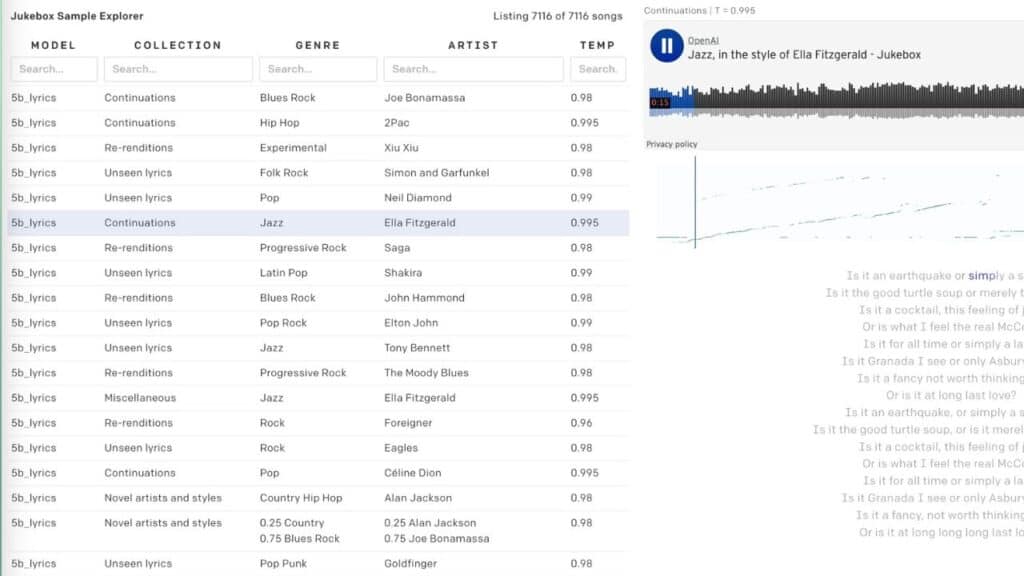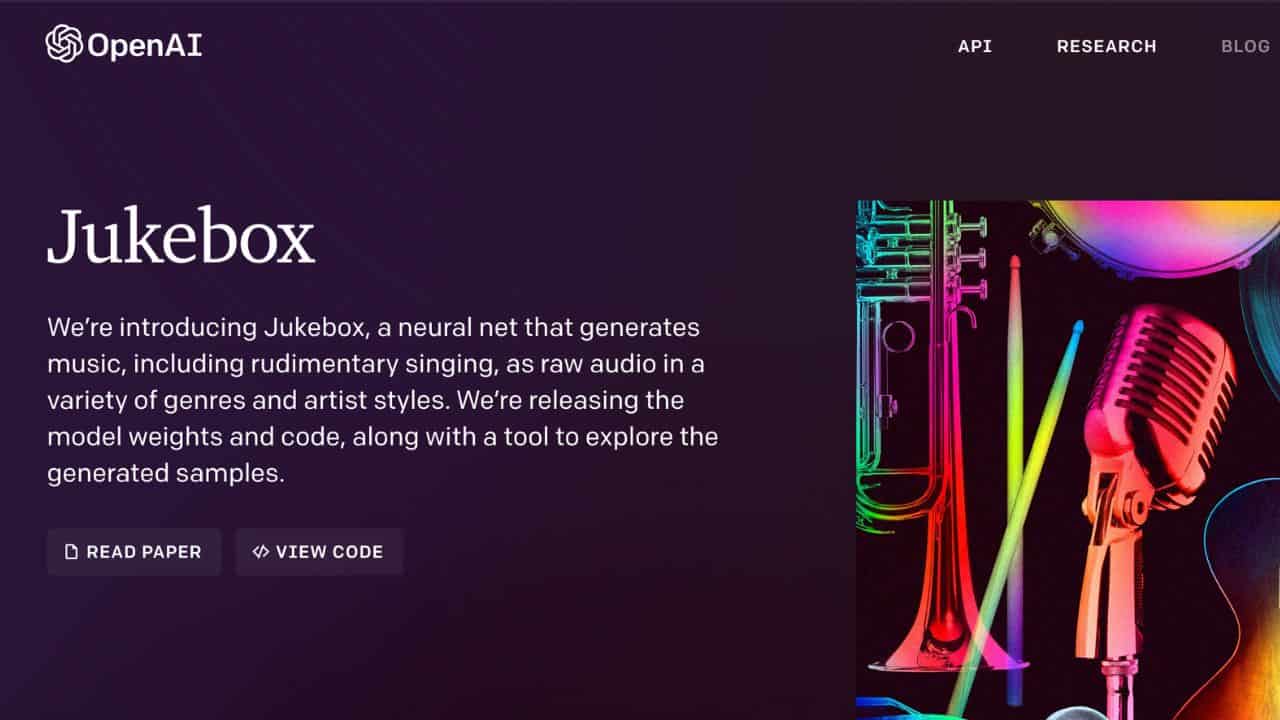AI has grown in importance, especially Generative AI in writing and image creation. But now we have a member on the list of generative AI creations, music. Now people can create or generate music using AI tools without spending hours in studios.

We have OpenAI’s music-making AI model, Jukebox starting in the world of AI music. The tool is far from complete and does not sound great, so t it has the potential to be a game-changing tool in the market.
So what is Jukebox all about, and how can someone use it? That is what we will answer in this article.
What is OpenAI Jukebox: AI That Generates Music as Raw Audio
Jukebox is OpenAI’s music generator that can create audio if information about music genre, artist, or even lyrics is provided. With all that information, this AI tool will work on creating a unique piece of music for you.
The music output will be in Raw format, which is the format that musicians work with when creating music. The format we listen to on our phones is mostly mp3 format songs heavily compressed in size and quality.
But Raw formats like aac are unaltered and uncompressed in every way. So the piece generated by Jukebox will be uncompressed and can be edited or changed in any way a musician wants. The RAW format will ensure greater customizing and editing options.
Unlike ChatGPT and Dall E, though, Jukebox did not come into the limelight of generative AI much. Its primary cause is the non-user friend web app and tediously long generation time.
To help you better understand, generating a minute-long audio file in Jukebox will require a total render time of something close to 9 hours.
It is more than just the long duration too. You might also have to tinker with some code to better interact with the model.
How Does the OpenAI Jukebox Work?
Unlike other AI tools, Jukebox cannot generate a song from scratch. It requires a combination of prerecorded samples or MIDI information to work on it using its digital synthesizer.
The digital synthesizer will analyze the input to produce an output that resembles the provided data.
This tool is more complex than what we see with other OpenAI tools like ChatGPT and Dall E, but it is only the beginning of AI in the music world.
How to Use OpenAI Jukebox
Much like what we see with other OpenAI tools, the process here is also somewhat similar. You enter the prompt describing the output you want and let the tool do its magic.
This tool lets you insert any sample of music as a reference either.

So firstly, you head over to the OpenAI website and download the Jukebox zip file. Once you have the zip file, unzip it and then run the openai-jukebox program file.
After this, provide a dataset of music files to the jukebox program and describe the type of output you expect from the Jukebox. Then let the tool do its job, and after hours of waiting, you will get your production the way you ordered it.
What Can You Do With Jukebox?
The jukebox can only be used as a tool to create unique music content that a content creator can use as its background audio.
Creating a full-fledged song on this tool is not possible at all. It is more like an experiment that can be edited or corrected to get a unique desired audio output.
If you plan to create music from scratch with Jukebox, you simply cannot do that.
OpenAI’s Jukebox Limitations
Significant limitations of OpenAI Jukebox can be narrowed down to two things:
- The music rendering time could be faster.
- The output is what you get in the end. You can modify the search to get any desired music, but there is only the ability to work and edit the final output. Unlike traditional means, you can’t edit or change the music as it is being prepared.
What is OpenAI’s Jukebox Future
OpenAi will slowly and gradually add more music to the training data of Jukebox, enabling it to work with all kinds of music worldwide.
Dall E 2 got better with more data getting into the training phase. We can expect something similar from Jukebox as well.
The world of music and its data is extensive and incomprehensible in measurable terms. It will take a while to incorporate more musical data into the tool’s training, but once it happens, we might see a tool that could create music just from a single text prompt.
What is the Alternative to the OpenAI Jukebox?
There are many AI music generators: Amper Music, AIVA, Ecrett Music, Soundraw, and Boomy. But the one that best works as a perfect alternative to OpenAI’s Jukebox is OpenAI’s very own MuseNet.
Musenet is easy to use and takes less time to create music.
Stay tuned for our other articles if you want to know more about these alternative options for AI music generators.
What Does Jukebox Sound Like?
The results that you get out of the Jukebox are far from perfect. Some might argue that the audio could be more usable for most people.
Listening to the music, you can make the shape of the audio and the genre it belongs to, but the sound quality is extremely muffled. It is like listening to old recorded music on an ancient musical device.
It sounds muffled in its output. The audio can also be closely related to the songs we hear on our radio when the frequency is not set perfectly. Some songs that come out sound like a remake of existing songs, while some sound like a continuation of existing songs.
The quality and output of the generated audio are not up to the mark in every standard, but the sheer ability to create any music you want is still astonishing.
As times go, we will see more sophistication come into tools like Jukebox, possibly making it the default choice for new content creators.
How OpenAI’s Jukebox Was Trained and How much data?
OpenAI’s Jukebox was trained with a dataset of over 1.2 million songs, all in English. So the primary training data for the model is old songs, and hence the output they generate mainly does sound like old songs playing on a radio.
In terms of number, 1.2 million might seem like a lot, but in terms of Dall E, hundreds of millions of images were used as a training model.
So, in that case, there is still a lot of training to do. On top of that, the data used in the datasets were only sometimes in consent with the creators. So there is a complication in terms of acquiring as well.
For now, most of the dataset comprises Western music, making it specific to a region. But human musical history far exceeds what 1.2 million songs can capture. With more data pouring in, we might see a better version of Jukebox soon.
Does AI Music Move You?
No, it does not move you as music usually does. To some extent, the music generated by AI is real music, and no one can dismiss that. But the quality of the piece could be better.
AI in music is not entirely a new concept altogether, though. We have seen some implementations but none as raw audio output.
Jukebox is the first to push out raw work but still lacks enough features and sophistication to be packaged as a commercial tool.
Actual human musicians still produce the best music to move someone, much like ChatGPT and Dall E cannot create the originality only a human can bring to the content.
